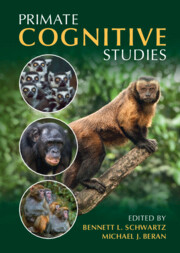Book contents
- Primate Cognitive Studies
- Primate Cognitive Studies
- Copyright page
- Contents
- Figures
- Tables
- Contributors
- Acknowledgments
- 1 The Purpose of Primate Cognitive Studies
- 2 A History of Primates Studying Primates
- 3 Genetic and Environmental Influences on Chimpanzee Brain and Cognition
- 4 The Evolution of Cognition in Primates, Including Humans
- 5 State of the Field
- 6 Current Perspectives on Primate Perception
- 7 The Comparative Study of Categorization
- 8 Numerical Cognition in Nonhuman Primates
- 9 The Natural History of Primate Spatial Cognition
- 10 Progress and Prospects in Primate Tool Use and Cognition
- 11 Sequencing, Artificial Grammar, and Recursion in Primates
- 12 The Evolution of Episodic Cognition
- 13 Metacognition
- 14 Bridging the Conceptual Gap between Inferential Reasoning and Problem Solving in Primates
- 15 The Eyes Have It
- 16 Social Cooperation in Primates
- 17 Primate Communication
- 18 Theory of Mind in Nonhuman Primates
- 19 A Requiem for Ape Language Research
- 20 Primate Empathy
- 21 Replication and Reproducibility in Primate Cognition Research
- 22 Ethical Considerations in Conducting Primate Cognition Research
- 23 Collaboration and Open Science Initiatives in Primate Research
- 24 Studying Primate Cognition
- 25 Do Monkeys Belong in the Ape House?
- Index
- References
24 - Studying Primate Cognition
From the Wild to Captivity and Back
Published online by Cambridge University Press: 28 July 2022
- Primate Cognitive Studies
- Primate Cognitive Studies
- Copyright page
- Contents
- Figures
- Tables
- Contributors
- Acknowledgments
- 1 The Purpose of Primate Cognitive Studies
- 2 A History of Primates Studying Primates
- 3 Genetic and Environmental Influences on Chimpanzee Brain and Cognition
- 4 The Evolution of Cognition in Primates, Including Humans
- 5 State of the Field
- 6 Current Perspectives on Primate Perception
- 7 The Comparative Study of Categorization
- 8 Numerical Cognition in Nonhuman Primates
- 9 The Natural History of Primate Spatial Cognition
- 10 Progress and Prospects in Primate Tool Use and Cognition
- 11 Sequencing, Artificial Grammar, and Recursion in Primates
- 12 The Evolution of Episodic Cognition
- 13 Metacognition
- 14 Bridging the Conceptual Gap between Inferential Reasoning and Problem Solving in Primates
- 15 The Eyes Have It
- 16 Social Cooperation in Primates
- 17 Primate Communication
- 18 Theory of Mind in Nonhuman Primates
- 19 A Requiem for Ape Language Research
- 20 Primate Empathy
- 21 Replication and Reproducibility in Primate Cognition Research
- 22 Ethical Considerations in Conducting Primate Cognition Research
- 23 Collaboration and Open Science Initiatives in Primate Research
- 24 Studying Primate Cognition
- 25 Do Monkeys Belong in the Ape House?
- Index
- References
Summary
How do nonhuman primates process information about their social and physical world, and how do they make decisions? To address this question, research in the tradition of ethology and behavioral ecology aims to uncover how animals behave under ecological and evolutionarily valid conditions. By combining detailed observations of behavior in the wild with field experimentation, such studies have shed light on what primates know about predators, their home ranges and food sources, and their social environment. A second research stream takes non-naturalistic experiments into freely moving groups of wild or captive primates to test social learning, problem-solving skills, and motivation. Finally, captivity-based studies address a wide range of questions, using an array of different methodological approaches, often with the aim to explore the limits of the animals’ abilities. This chapter compares the strengths and the limitations of the different research streams and proposes an integrative approach to developing a profound understanding of primate cognition.
Keywords
- Type
- Chapter
- Information
- Primate Cognitive Studies , pp. 609 - 631Publisher: Cambridge University PressPrint publication year: 2022
References
- 2
- Cited by

